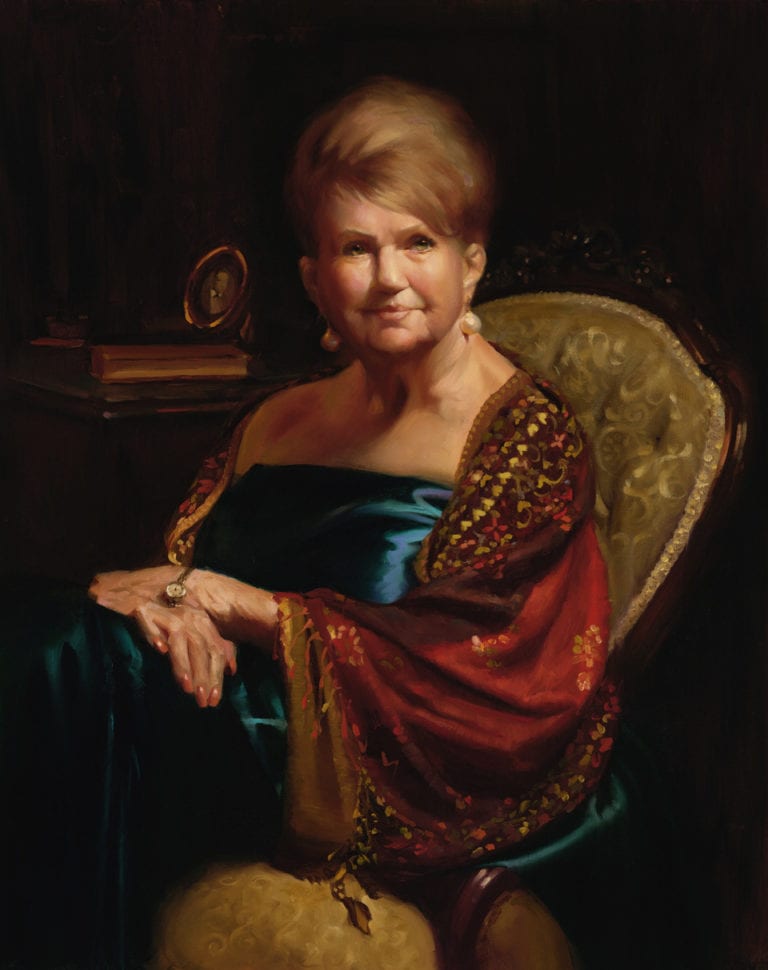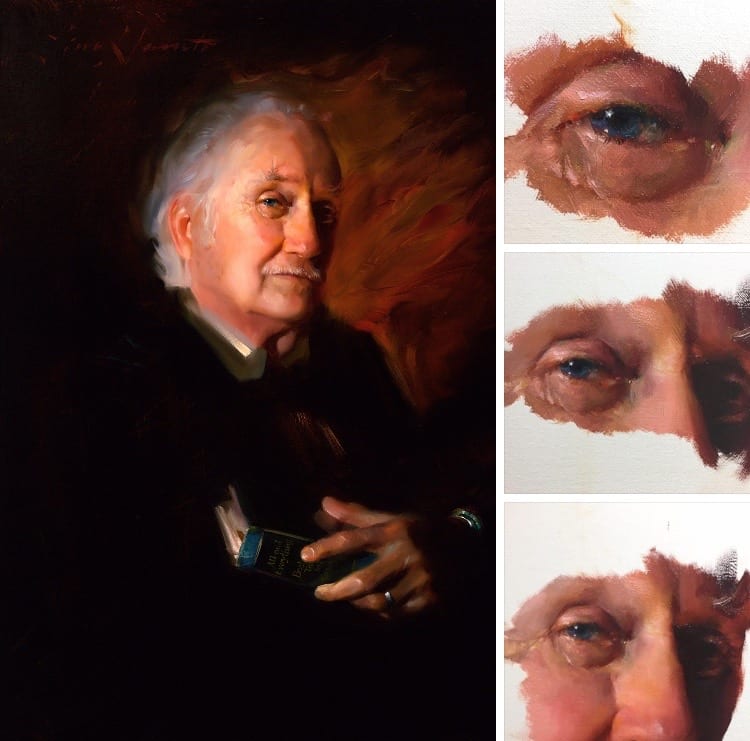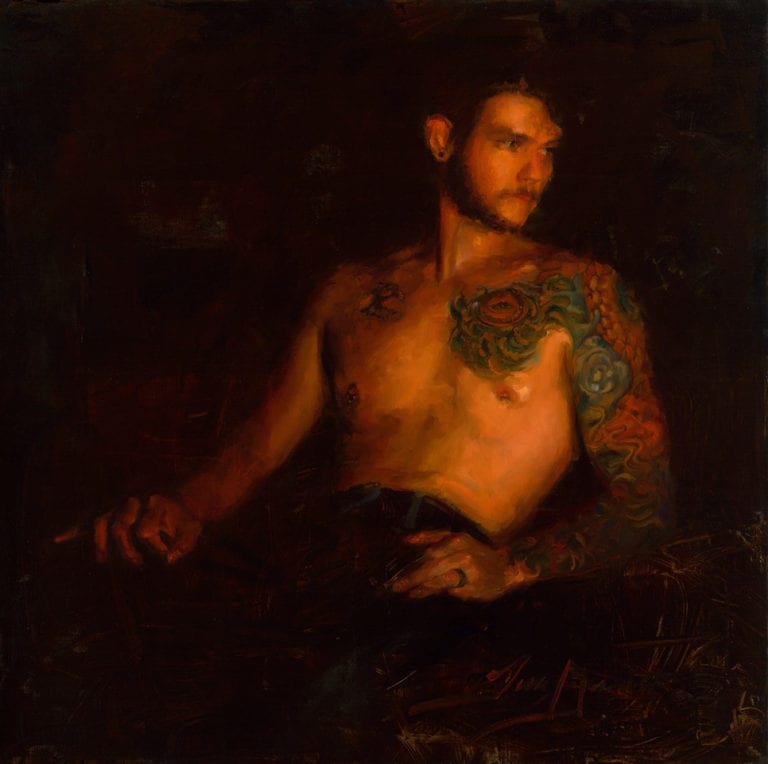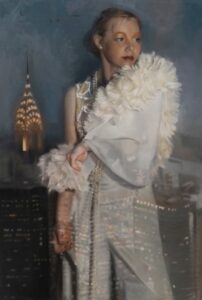I’ve often heard artists lament how much they hate painting commissioned portraits. I never understood why. After all, a commission is a guaranteed sale which means the artist doesn’t have to work hard to find a buyer, or split their profit with a gallery or broker. The artist doesn’t have to generate the idea for the work completely on their own or even store the painting until it sells.
So I started asking artists what it is about commissions that they hate so much. They described to me a process of tortured meetings where collectors make endless changes to the originally described project, budget or deadlines; pressured painting sessions under the shadow of collectors as they scrutinize each brush stroke; endless changes to finished works; and even knocking down doors to get paid.
Well, goodness, I would hate commissions too if that was what they looked like for me. Let me walk you through the commission process I offer to collectors and invite you to take on any or all parts of my approach. Hopefully you will have more success with commissions and they will be more fun for both you and your clients.

30″ x 24″ – Oil, Finalist in the Portrait Society of America Members Only Competition
It starts with being honest:
If the artwork you create and sell is the source of your primary income, you may feel compelled to say yes to every commission you are offered. Because you need the work, you may be afraid to ask for specific working conditions to suit your personality or financial needs. As a full-time professional artist I completely understand this dilemma and want to encourage you to consider creating a standard for your working process that will help you protect your creative integrity.
First, I encourage you to take only the commissions that you are truly inspired to paint. “But won’t that make me less money Tina?” The answer is yes and no. Yes, you may turn away a portion of the commissions you usually take. However, your new standard will help you take on commissions that are such a good fit for you and create working conditions that are much less stressful and take less of your time and energy. With working conditions that you are truly comfortable with, you will make better paintings and this will help you build your brand and portfolio, which in turn can increase the overall value of your work.
From my experience, when artists create work that they are not truly excited and inspired to make — either because they are doing it strictly to get paid or because they are painting what they think they are supposed to paint — that work is usually not the best quality and is certainly not fulfilling. And, even if an artist is truly inspired about the subject, but the working conditions are packed with unknown variables such as changing deadlines or evolving expectations, the stress far outweighs the pay.
So how does one paint commissions without the process becoming soul crushing work? The trick is to be honest with yourself and your potential collectors. For me, I absolutely love painting commissions because I know with 100% certainty that the painting I create will be loved for at least as long as the collector is living and probably another generation or two. And that truly is the driving factor for me. I love the works that I create. They are a part of me and when I send them off into the world I am so hopeful that they will continue to make their mark and speak for me many years into the future. But I am able to focus on that fulfilling aspect of commissioned painting because I’m not torturing myself with a process that gives all my creative control away. I know myself. I protect myself from the things that I know will crush my confidence and if a client cannot agree to the terms I need, then I am not the right artist for their project.
Set the terms and present them clearly:
The easiest way for me to explain how I express my needs to a client is for you to sit in on the conversation. So here we go…

34″ x 24″ – Oil, (shown here with in-progress images done in the Selective Start Method).
Client: Hi Tina, I heard about you from “so and so.” They love the painting you did of their granddaughter. I would like to have a portrait made of my grandchild.
Me: Hi! I’m so happy to get to visit with you and I’ll have to send a thank you to “so and so”. I really enjoyed painting their precious grandbaby. Tell me more about your grandchild and what you envision for your painting.
Client: Well I love what you did for “so and so.”
Me: Great! She is precious, it was so easy to be inspired to paint her. How old is your grandchild? Where do they live? Are they old enough to have any say…are they excited to have their portrait painted? (NOTE: Age isn’t really the concern. If they are an adult it wouldn’t matter either…if they don’t want a portrait made it makes the process much more difficult and I usually decline to take the project until the subject is fully on board.)
Client: Yes, they are 10 years old and live out west. They are a little nervous to be painted since they’ve never sat for a portrait before.
Me: That’s okay! I’ll take the time to introduce myself and let your grandchild in on my creative process before we ever meet in person, I can let them join in on some live online painting broadcasts! This usually gets the subject excited and makes our time together a special experience.
Me: What is your budget and what timeline are we looking at? (NOTE: I am always careful to make sure that I have something to offer for a wide range of budgets, if I’m excited about their project AND if they accept the terms I must have in order to take the project. And, I usually take one to three commissions a year and I typically need to get the commission at least three months ahead of the deadline.)
Client: We were hoping to have the painting in time for the holidays. The budget is moderate and we’re hoping that’s enough to get the same kind of painting you did for “so and so.”
Me: If we get started by “blank date” I’ll have time to meet your holiday deadline. I agree, the painting I did for “so and so” is one of my very best works. A work similar would be in the above average price range. With a moderate budget, I can offer a monochrome or one color head and neck oil sketch. If you’d like to have a full color, full figure fine art oil painting, I do offer no interest monthly payments. You’d get to bring the painting home as soon as it is paid in full. (NOTE: I factor travel, framing and shipping into my prices, which can bump a painting into a different price range. In this case, painting or photographing the subject requires me to travel to them, so the price is above average, even though it is only a monochrome. Be sure to know what you are including in your pricing so you don’t end up working for a wage that cannot sustain your needs.)
Client: Is it less expensive if we do the framing?
Me: Thanks for asking, but no. The majority of the price is determined by how complex the commissioned process is and any travel I do. If you can wait until “such and such date” I’ll be nearby teaching an oil painting workshop. Your grandchild can stop in to say hi and we can eliminate the travel costs in this estimate. Otherwise, the less expensive options are one color or a head and shoulders sketch; the price increases if the work is full color, full figure and/or multiple subjects. I’ve texted you an example of low, moderate and above average budget works so that you can compare.
Client: Oh! I actually love the one-color options, but I still want a full color formal painting and I cannot wait until “such and such date” — so instead of the full figure like “so and so’s”, how about just the head and shoulders?

30″ x 30″ – Oil (I let the client title this one) – Winner of the BoldBrush Award
Me: Wonderful! That is right in your budget! Let me quickly go over my process with you just to be sure that I am the right artist for your project. I have a specific process that helps me be confident and ensures that I am capable of creating a work of art that you and your grandchild will treasure for years to come. (NOTE: Here is where you insert YOUR preferences, but below are mine.)
I’m glad we have had this conversation, I fully understand the vision you are hoping for and I can get creatively excited about it. This is an important step because this enthusiasm is what I will use to help me solve the problems during the painting process. (NOTE: In this case it is easy to know what they want because they have referred to another artwork I have done and have seen other paintings of mine. That’s not always the case. I like to make sure clients have a visual to point to when telling me what they want, so I provide them with images of my previous works or works by the old masters to help them describe their vision to me and also I am able to hold them to it.)
Next, I’ll give you an exact price and estimated delivery date. Every aspect of the process will be included in that one price, including any travel I need to do, photography or painting from life sessions, creating the work, framing the work and safe and insured delivery of the work — that’s all included.
I require 50% of the total at the time we sign my contract. That amount is non-refundable. It holds the spot on my calendar and pays for my travel and materials expenses.
I will produce for you an image, we’ll call it a map, since it will be what I use to get to the painting you will love. The map may be a sketch using art materials or a digital image and you will be able to change any aspect of it or have me try again completely, even if it means I have to travel again to paint from life or gather more photo references. Those fees are already included. (NOTE: If traveling is part of the process, I stay in town until I have approval of the map.)
Once an image has been approved, I will create your actual oil painting and present it to you to either accept or reject. To protect my process and give me the confidence to make the best work I am capable of, I do not make changes to my oil paintings and I do not offer opportunities to comment on the work in progress.
If the finished painting is accepted, the other 50% (which is also non-refundable) is due at that time, unless we’ve set up a payment plan. The painting will be shipped to you upon receiving the full payment. If you can agree to these terms, I’d love to be the artist for your special project.
Client: That works for us. But out of curiosity, what happens to the painting if we reject it?
Me: I’m so glad you asked! First of all, my goal is to make the best work I’m capable of so that you will not only accept it, you’ll love it forever! But, if for any reason I don’t hit the mark, you simply don’t pay the other 50% and I keep the painting. I can paint over it, sell it to someone else, enter it into competitions for shows, etc. But I’ve only ever had one rejection, and it sold to the first collector I showed it to before it was even dry. I hope that helps you feel confident in working with me.
Client: It does. Thank you!
But Tina, what if the client’s idea is weird or too difficult for me?
Part of protecting your creative integrity means being honest about your own taste and abilities. It isn’t fair to your collector or yourself if you misrepresent your abilities. That doesn’t mean you shouldn’t push yourself or take risks, but I recommend you do that with the work you paint for yourself, not your commissions. Once I was approached to paint a scene that was far too difficult for me and the client wanted it painted in a style that I don’t typically paint in. It would have paid well. But I know myself and so I know I would have been too stressed trying to accomplish the complicated scene. In addition, the styling was so different from my usual work, I am sure that painting would have looked like an outsider when compared to the body of my work. On top of all those challenges, that painting wasn’t going to help promote my brand or be a valuable addition to my portfolio. I simply told the collector that I was not the artist for their project, but I did have the business cards of a couple artists I thought would do the job right.
In conclusion:
It may take a while for you to fully understand your own boundaries and learn how to communicate them with confidence, but it will be more than worth it. Be honest with yourself about the terms you are comfortable with and have the courage to say them out loud in your conversations and state them clearly in your contracts. This will give you the chance to enjoy commissions, earn the respect of your collectors and protect your creative integrity.




